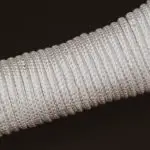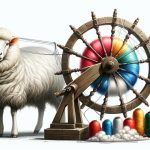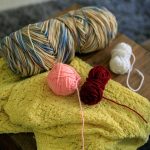Are you interested in crafting and sewing? If so, you’ve probably encountered the terms ‘yarn’and ‘thread’before. While both are types of materials used in crafting, they have distinct characteristics and uses that set them apart from each other.
Yarn is typically made up of fibers that have been spun together to create a long, continuous strand. It comes in a variety of thicknesses and textures, and is often used for knitting, crocheting, and weaving.
On the other hand, thread is a thin strand of twisted fibers that is used for sewing and embroidery.
In this article, we’ll dive deeper into the characteristics and uses of both yarn and thread, and help you determine which material is best suited for your project.
Table of Contents
Definition and Overview of Yarn and Thread
Yarn and thread are both types of fibers that are used for various purposes. Yarn is typically made of multiple fibers twisted together to create a thicker strand, while thread is made of a single fiber that is twisted and then wound onto a spool or cone.
Yarn is usually thicker and heavier than thread, which tends to be finer and more delicate. It is commonly used for knitting, crocheting, and weaving. Yarn can be made from a variety of materials, such as wool, cotton, silk, or acrylic. The weight or thickness of yarn can affect the final outcome of a project. Thicker yarn can create a more bulky and warm texture, while thinner yarn can create a more delicate and lacy texture.
Thread, on the other hand, is commonly used for sewing or embroidery. It is typically made from materials such as cotton, polyester, or nylon. Thread also comes in different weights or thicknesses, which can affect the durability and appearance of the final product. Thicker thread can be used for heavy-duty sewing, while thinner thread is better suited for delicate fabrics or embroidery work.
In summary, while yarn and thread may seem similar, they have distinct characteristics and uses that make them valuable for different types of projects.
Characteristics of Yarn
When it comes to yarn, you’ll find that it’s made from a variety of materials, including wool, cotton, silk, and acrylic. The thickness and texture can also vary greatly, from thin and smooth to thick and bulky.
And let’s not forget about the endless array of colors and varieties available, from solid colors to variegated and self-striping options.
Materials Used
The type of fabric and project dictate the ideal material for thread or yarn, with factors such as durability and texture playing a role in the decision-making process.
Yarn is typically made from a variety of materials, including wool, cotton, acrylic, and silk. Each material has its own unique characteristics, such as wool being warm and stretchy, cotton being cool and breathable, acrylic being soft and easy to care for, and silk being shiny and luxurious.
Thread, on the other hand, is usually made from cotton, polyester, or nylon. Cotton thread is ideal for natural fibers such as cotton and linen, while polyester and nylon thread are stronger and more durable, making them better suited for synthetic fabrics like polyester or nylon.
Ultimately, the material used for yarn or thread should match the needs of the project, ensuring the best possible outcome.
Thickness and Texture
Optimal results are achieved by matching the project’s requirements with the appropriate thickness and texture of thread or yarn. Thread is typically thinner and smoother than yarn, making it suitable for projects that require precision and detail, such as sewing buttons or creating intricate embroidery. Thread also comes in a wide variety of colors, making it easy to match the thread to the fabric or project at hand.
On the other hand, yarn is generally thicker and has more texture than thread. This makes it ideal for knitting or crocheting projects, as the texture and thickness can add depth and interest to the final product. Yarn also comes in a range of thicknesses, from super fine to super bulky, allowing for even more versatility in crafting projects.
When choosing between yarn and thread, it’s important to consider the project’s requirements and the desired outcome to determine which material will best suit your needs.
Colors and Varieties
Colors and varieties abound in the world of crafting, offering endless possibilities for adding personal flair and creativity to any project. Yarn and thread come in a wide range of colors, from bright and bold to soft and subtle, making it easy to find the perfect hue for any project. Additionally, both yarn and thread are available in a variety of textures, from smooth to fuzzy, allowing crafters to choose the best texture for their project.
When it comes to varieties, yarn and thread offer an array of options. Yarn can be made from different materials, including wool, cotton, and acrylic, each with their own unique properties. Thread also comes in different materials, such as cotton, polyester, and silk, each with their own strengths and weaknesses. The table below highlights some of the most common types of yarn and thread, along with their characteristics and best uses.
| Type | Characteristics | Best uses |
|---|---|---|
| Wool | Warm, elastic, natural | Sweaters, scarves, hats |
| Cotton | Soft, breathable, absorbent | Dishcloths, summer garments, baby items |
| Acrylic | Durable, lightweight, affordable | Blankets, hats, scarves |
| Silk | Shiny, strong, luxurious | Embroidery, fine fabrics, jewelry making |
| Polyester | Strong, resistant to wrinkles and shrinking | Sewing, quilting, embroidery |
| Nylon | Elastic, durable, water-resistant | Outdoor gear, swimwear, lingerie |
Uses of Yarn
You might love to knit, crochet, or weave, and all of these crafts require yarn. Yarn is the basic material that you use to create beautiful and functional items such as scarves, socks, blankets, and more.
With the right type of yarn, you can create a wide range of textures and patterns that make your projects unique and special.
Knitting
Imagine holding a cozy knitted scarf made with soft yarn that warms you up on a chilly day. Knitting is one of the most popular uses of yarn. It is a method of creating a fabric using two or more needles to loop yarn together. Knitted items can range from simple scarves to intricate sweaters and blankets. Many people enjoy knitting as a hobby and find it to be a relaxing and creative outlet.
To give you an idea of the possibilities with knitting, here’s a table showcasing different types of knitted items and the emotions they may evoke:
| Type of Knitted Item | Emotion Evoked |
|---|---|
| Baby Blanket | Cozy, Comforting |
| Sweater | Warm, Nostalgic |
| Scarf | Cozy, Comforting |
| Socks | Cozy, Playful |
| Hat | Stylish, Practical |
Whether you’re knitting for yourself or for someone else, the end result is sure to bring joy and warmth to whoever wears it. So why not pick up some yarn and give knitting a try?
Crocheting
Get ready to dive into the world of crocheting, where you can create beautiful and intricate designs with just a hook and some yarn. Crocheting is a versatile craft that allows you to create a wide range of items such as blankets, scarves, hats, and even clothing.
Unlike knitting, which uses two needles, crocheting only requires one hook, making it easier to learn and perfect. Crocheting also offers more flexibility when it comes to yarn choices. While some yarns are specifically designed for knitting or crocheting, many can be used for both.
However, crocheting allows you to create a variety of stitch patterns that showcase the unique qualities of different yarns. This means you can experiment with a variety of yarns, from soft and fluffy to textured and chunky, to create one-of-a-kind pieces that are both functional and beautiful.
So, grab your hook and some yarn, and get ready to explore this wonderful world of crocheting!
Weaving
Weaving is a fascinating craft that allows you to create beautiful and intricate patterns using a loom and various fibers. With weaving, you can create fabrics, rugs, and even tapestries. The process involves interlacing different threads or yarns to form a fabric, and it requires patience and practice to master.
Here are some key points to keep in mind when weaving:
- You can use a variety of materials for weaving, including cotton, wool, silk, and linen.
- There are different types of looms, such as the rigid heddle loom and the floor loom, each with their own advantages and disadvantages.
- The warp threads are the foundation of the weaving, and they are the threads that are stretched vertically on the loom.
- The weft threads are the threads that are woven horizontally through the warp threads to create the fabric.
- You can create different patterns and textures by changing the color, thickness, and pattern of the yarns you use.
Overall, weaving is a versatile and rewarding craft that allows you to create unique and beautiful pieces. It takes time and practice to master, but with dedication and patience, you can create stunning works of art.
Characteristics of Thread
When you’re choosing thread for a project, it’s important to consider its weight, fiber content, and color. The weight of the thread determines its thickness and how visible it will be in the finished product. For example, a heavier weight thread may be better for a quilt or upholstery project, while a lighter weight thread is more suitable for delicate fabrics like silk or chiffon.
The fiber content of the thread is also important to consider. Cotton and polyester are common choices for sewing thread, but silk and wool threads are also available. The fiber content can affect the strength and durability of the thread, as well as its appearance. For example, a silk thread may have a luxurious sheen, while a cotton thread may have a more matte finish.
Color is an important consideration when choosing thread. You’ll want to choose a thread color that matches or complements your fabric, or that will provide a contrasting accent. Some threads are also available in variegated colors, which can add interest and dimension to your project.
With these factors in mind, you can choose the perfect thread for your next sewing project.
Uses of Thread
You can use thread in a variety of ways, such as sewing together pieces of fabric, adding decorative accents to a garment, or creating intricate embroidery designs.
When sewing, you need to choose the right type of thread for your project as each kind has different properties and strengths. For example, cotton thread is perfect for sewing lightweight fabrics, while nylon thread is ideal for heavy-duty sewing like leather or canvas.
Decorative accents are another great way to use thread. You can add colorful embroidery to a plain shirt or dress, creating a unique and personalized garment. You could also use metallic thread to add some sparkle to a piece of fabric, perfect for a special occasion outfit.
Intricate embroidery designs are a beautiful and delicate way to use thread. Whether you’re creating a small design on a napkin or a larger one on a pillowcase, embroidery is a great way to add a personal touch to any item. With a wide variety of colors and textures available, you can create a truly stunning piece with just a needle and thread.
Differences Between Yarn and Thread
When it comes to crafting, it’s important to know the differences between yarn and thread.
First, yarn is typically thicker and bulkier than thread, which is much thinner.
Second, yarn is made from fibers like wool and cotton, while thread is often made from synthetic materials like polyester.
Finally, yarn is ideal for larger projects like blankets or scarves, while thread is better suited for sewing and embroidery.
Thickness and Bulkiness
Feeling overwhelmed by the variety of yarn and thread thicknesses? Don’t worry, it’s common to get confused when trying to choose the right one for your project! Understanding the differences in thickness and bulkiness can help you select the best material for your project.
Here are some things to keep in mind:
- Yarn is typically thicker and bulkier than thread. It’s often used for knitting, crocheting, and weaving projects that require a certain level of warmth, softness, and texture.
- Thread, on the other hand, is thinner and more delicate than yarn. It’s commonly used for sewing projects that require precision and strength, such as attaching buttons, hemming, and quilting.
The thickness of yarn and thread is measured differently. Yarn thickness is often measured in ply, which refers to the number of individual strands that are twisted together to form the yarn. Thread thickness, on the other hand, is measured in weight or thickness, using a standardized system of numbers and letters.
It’s important to choose the right thickness of yarn or thread for your project, as it can affect the overall look, feel, and durability of your creation. Consider the type of project you’re working on, the desired outcome, and the level of skill required to work with different types of materials.
By keeping these factors in mind, you can confidently choose the right thickness and bulkiness of yarn or thread for your project, and achieve the desired results.
Materials Used
Learning about the materials utilized in various projects can improve your understanding and skill in the art of crafting. When it comes to yarn and thread, the materials used in their production can greatly affect their characteristics and uses.
Yarn is typically made from natural or synthetic fibers such as cotton, wool, acrylic, or nylon. These fibers are spun together to create a long, continuous strand that can be used for knitting or crocheting. The type of fiber used can greatly affect the texture, softness, and durability of the yarn.
On the other hand, thread is usually made from a single strand of cotton or polyester. It is much thinner than yarn and is often used for sewing or embroidery projects. Thread can also come in different weights or thicknesses, making it suitable for a variety of projects.
The materials used in thread production are carefully selected to ensure that they are strong enough to withstand the tension and stress of sewing. By understanding the materials used in yarn and thread production, you can better select the right material for your project and achieve the desired results.
Uses
Now that you’ve got an understanding of the materials used in yarn and thread, let’s dive into their uses.
Yarn is commonly used for knitting, crocheting, and weaving. It comes in a variety of thicknesses and fibers, making it versatile for different projects. For example, thicker yarn may be used to make a cozy blanket while thinner yarn can be used to create delicate lacework.
Yarn can also be used for embroidery and embellishing fabrics.
On the other hand, thread is typically used for sewing. It’s made from a variety of fibers, such as cotton, polyester, and silk, and comes in different weights. The weight of the thread depends on the type of fabric it’s being used on and the purpose of the stitching.
For example, a heavier thread may be used for denim while a lighter thread may be used for delicate fabrics like silk.
Thread is also used for embroidery and quilting projects.
Choosing the Right Material for Your Project
Selecting the appropriate material for your project is crucial, as it can greatly impact the outcome of your finished product when it comes to yarn and thread. Here are some factors to consider when choosing between the two:
-
Purpose: Yarn is typically used for creating larger, more decorative pieces such as blankets, scarves, and sweaters. Thread, on the other hand, is better suited for smaller, more intricate projects such as embroidery or sewing buttons.
-
Material: Yarn and thread come in a variety of materials, each with its own unique characteristics. For example, cotton yarn is perfect for summer garments, while wool yarn is better suited for winter wear. Similarly, silk thread is ideal for delicate fabrics, while polyester thread is more durable and can withstand higher temperatures.
-
Color and texture: Yarn and thread come in a rainbow of colors and textures, so it’s important to choose the right one for your project. Consider the overall look you’re going for, as well as any textural elements you want to incorporate.
By taking these factors into account, you can ensure that you’re choosing the right material for your project. Whether you’re creating a cozy blanket or a delicate embroidery piece, the right yarn or thread can make all the difference in the final product. So take your time, do your research, and select the perfect materials to bring your vision to life.
- Tetron Fabric for Marine Applications: Durability and Use Cases - June 18, 2025
- Tetron Fabric for Outdoor Furniture: Weather Resistance and Care - June 18, 2025
- Tetron Fabric for Wall Coverings: Style and Application Tips - June 18, 2025




